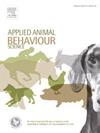What a camera trap survey can reveal about the behaviour of an invasive species: Insights from coypus Myocastor coypus in an urban park of central Italy
IF 2.2
2区 农林科学
Q1 AGRICULTURE, DAIRY & ANIMAL SCIENCE
引用次数: 0
Abstract
Assessing the behaviour of invasive alien species is fundamental for their management. Coypu occurrence outside the native range poses ecological and economic threats, and effective management strategies are crucial, particularly in urban areas where interactions with humans are the most frequent. In this work, we analysed the temporal patterns of activity and behavioural repertoire of an urban population of coypus in central Italy, by means of camera trapping and focal sampling. Activity rhythms and time budget were estimated throughout the year and compared across seasons, sexes, and age classes; overlaps in coypu activity patterns with co-occurring potential predators and competitors were also assessed. Differently from natural areas, coypus in our study site were primarily crepuscular and nocturnal, with a significant reduction in activity during bright moonlight periods to limit predation risk, showing a high overlap with red foxes (the main natural predator) but minimal overlap with humans and unleashed dogs. Coypus spent most of their time swimming and foraging. Adult males were territorial and were the only sex scent-marking on both land and woods. Adult females played a crucial role in protecting offspring, together with subadults, and defended dens with cubs from conspecific and other species. Playing was strictly a kit prerogative. In general, controlling coypu populations, as imposed by EU regulations, is challenging due to their adaptability and high reproductive rate. We suggest that trapping efforts should focus on night-time activities near water bodies during warmer months, when coypu are more active on the land and thus more likely to encounter land-based traps. Overall, this study provides valuable insights into the ecology and behaviour of coypu in urban environments, aiding in the development of effective management strategies to mitigate the species impacts on native biodiversity and environments.
求助全文
约1分钟内获得全文
求助全文
来源期刊

Applied Animal Behaviour Science
农林科学-行为科学
CiteScore
4.40
自引率
21.70%
发文量
191
审稿时长
18.1 weeks
期刊介绍:
This journal publishes relevant information on the behaviour of domesticated and utilized animals.
Topics covered include:
-Behaviour of farm, zoo and laboratory animals in relation to animal management and welfare
-Behaviour of companion animals in relation to behavioural problems, for example, in relation to the training of dogs for different purposes, in relation to behavioural problems
-Studies of the behaviour of wild animals when these studies are relevant from an applied perspective, for example in relation to wildlife management, pest management or nature conservation
-Methodological studies within relevant fields
The principal subjects are farm, companion and laboratory animals, including, of course, poultry. The journal also deals with the following animal subjects:
-Those involved in any farming system, e.g. deer, rabbits and fur-bearing animals
-Those in ANY form of confinement, e.g. zoos, safari parks and other forms of display
-Feral animals, and any animal species which impinge on farming operations, e.g. as causes of loss or damage
-Species used for hunting, recreation etc. may also be considered as acceptable subjects in some instances
-Laboratory animals, if the material relates to their behavioural requirements
 求助内容:
求助内容: 应助结果提醒方式:
应助结果提醒方式:


